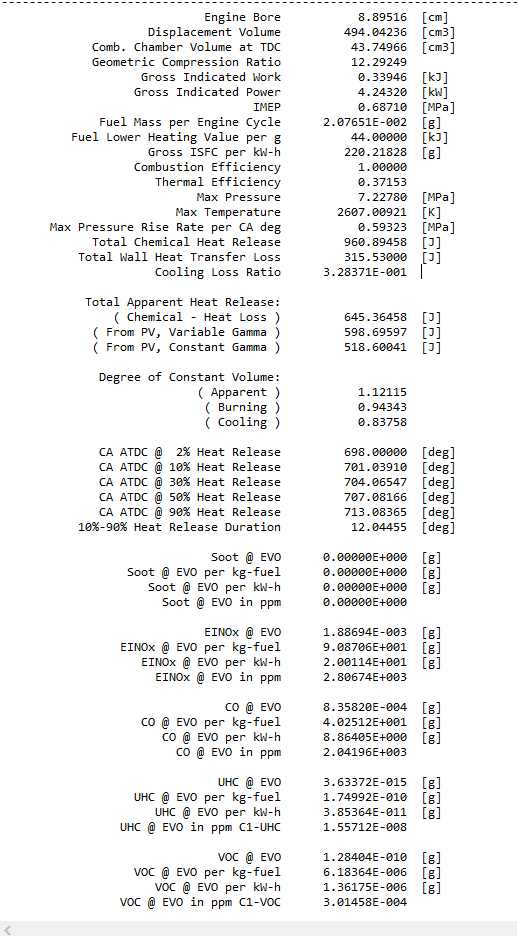TAGGED: ansys-forte, chemkin, forte, reaction-design
-
-
June 23, 2021 at 6:35 pm
sridharsahoo366
SubscriberRecently, I was simulating the tutorial file "SIEngine_PortInjected_AMG_Tutorial.ftsim". After the simulation completed I got some results. I have some basic questions that make me doubt the solver, maybe I am wrong.
The questions are as follows:
- 100% combustion efficiency. ( On which basis combustion efficiency is calculated? ) I calculated fuel mass multiplied by LHV which is greater than the chemical heat release rate. How is that possible? This seems like an ideal case.
- UHC is almost zero. How is this possible?
- Fuel Mass per Engine Cycle is showing 2.07651E-002 [g], whereas in the excel sheet iC8H18 concentration is 2.18E-002 gram before combustion. Why there is a deviation?
- Fuel Lower Heating Value per g 44.00000 [kJ]. This LHV value remains the same if I change the combustion from gasoline to CNG also. I guess it may affect results also.
Please answer these questions.
July 8, 2021 at 4:23 pmRahul Kumar
Ansys EmployeeHello 1) 3) and 4): Believe it or not, it is not very straightforward to let the software detect how much fuel is trapped inside the cylinder in a fully automatic way, mainly because there are many different use cases in which fuel is introduced into the domain and simulation is set up. The fuel mass reported in the summary data is the hydrocarbon species that comes into the computational domain through open boundaries. It could be different from the actual amount of fuel trapped in the cylinder. The mass reported in the table is 2.07651E-2 g. While if we check the ic8h18 mass in speciesmass.csv after IVC but before combustion, the mass is 2.18E-2 g. This is exactly what you observed. Also, it is not straightforward to obtain the heating value for each fuel (hydrocarbon) species automatically unless the fuel is injected through spray. This is because the gas phase chemistry mechanism does not contain LHV inputs for each hydrocarbon species. This is why 44 kJ/g is used as approximation. The LHV of isooctane is 44.3 kJ/g, which is higher than the assumed 44 kJ/g. These two factors make the accumulated heat release rate higher than the heating value derived based on the table. In summary, the accumulated chem heat release rate is correct, but the fuel mass and LHV are approximated. We added several "disclaimers" in FORTE.log above the engine performance data table, but we are working on a different way for reporting these data such that it can be more flexible and can cover more use cases more accurately.
2) The fuel/air mixing is simplified in this setup - fuel and air are perfected mixed when coming into the domain through the inlet. This is why the combustion is complete and leaves little unburned HC. If port fuel injection is modeled and if the engine geometry contains crevice volume and other fine features, such as spark plug recess etc., there will be unburned HC emissions.
July 8, 2021 at 4:28 pmsridharsahoo366
SubscriberThank you.
Viewing 2 reply threads- The topic ‘Why the unburnt hydrocarbon emission is zero in Port fuel SI engine simulation using Ansys Forte ?’ is closed to new replies.
Ansys Innovation SpaceTrending discussionsTop Contributors-
3622
-
1303
-
1122
-
1068
-
1008
Top Rated Tags© 2025 Copyright ANSYS, Inc. All rights reserved.
Ansys does not support the usage of unauthorized Ansys software. Please visit www.ansys.com to obtain an official distribution.
-
The Ansys Learning Forum is a public forum. You are prohibited from providing (i) information that is confidential to You, your employer, or any third party, (ii) Personal Data or individually identifiable health information, (iii) any information that is U.S. Government Classified, Controlled Unclassified Information, International Traffic in Arms Regulators (ITAR) or Export Administration Regulators (EAR) controlled or otherwise have been determined by the United States Government or by a foreign government to require protection against unauthorized disclosure for reasons of national security, or (iv) topics or information restricted by the People's Republic of China data protection and privacy laws.












